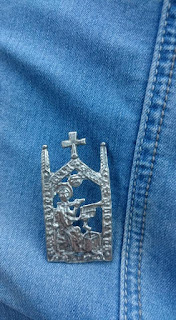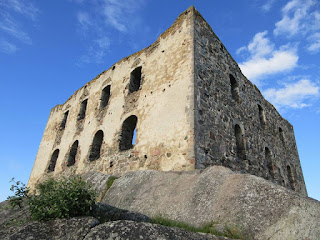Uutta matkaraporttia pukkaa! Ohjelmassa oli viikon matka Ruotsin kautta Tanskaan, ja vaikka varsinainen kohde oli Middelaldercentret Nyköbing Falsterissa, ehdimme matkan varrella piipahtamaan kovin monessa kohteessa, aikajännekin kohteilla ulottui neoliittisesta kivikaudesta kustavilaiseen aikaan. En edes kuvittele jakavani koko reissua yhdessä postauksessa (ihan jo kiitos kuvamääränkin), eli matkaraportti reissusta jaetaan kolmeen osaan. Luvassa siis ensimmäisessä osassa menomatka, ts. Ruotsin kohteet, toisessa osassa itse Middelaldercentret ja kolmanteen osaan säästetään paluumatka.
New travel report coming up! We spent a week traveling through Sweden to Denmark, and while our actual destination was Middelaldercentret in Nyköbing Falster, we had a chance to drop by at several different interesting sites and sights spanning from the neolithic stone age to the 18th century. I don't even think of sharing all of the trip in one post (not least for the amount of pictures involved), so I'll divide the report to three parts. First, our way through Sweden, second, our stay at Middelaldercentret, third, back from Denmark through Sweden.
Eli, aloitetaanpa alusta! Koska ajatuksena olikin ottaa matka melko rauhassa (suhteellinen käsite sekin), ehti matkan varrelle suunnitella kaikenlaista. Silti matkan ensimmäinen kohde oli vähän yllätys, kun lähdimme Tukholmasta ajelemaan kohti Nyköpingiä ja varsinaisia ensimmäisiä suunniteltuja kohteita. Koska Turusta tuleva autolautta on satamassa hävyttömän aikaisin, olimme jo ennen kahdeksaa paikallista aikaa hyvän matkaa Tukholman ulkopuolella. Tämä jätti aikaa improvisaatiolle, eli kun ajellessa vastaan tuli nähtävyydestä vihjaava hannunvaakunamerkki, ei kun auton nokka uuteen suuntaan.
Eli ensimmäkseksi kohteeksi valikoitui vähän sattumalta Tullgarnin linna hiukan reilun tunnin ajon päässä Tukholmasta. 1500-luvulla alkujaan Sture-suvulle rakennettu mutta sen jälkeen muodonmuutoksia kokenut linna oli 1700-luvun loppupuolelta 1950-luvulle saakka kuninkaallisena kesäasuntona. Koska olimme liikkeellä hirveän aikaisin linna ei ollut vielä auki, mutta puistoon pääsi ihastelemaan kieltämättä varsin komeita merenlahden näkymiä.
Let's start from the beginning. Since our master plan was to travel with good time (which indeed is a debatable concept just by itself), we had planned on seeing several different sights along our route. Yet, our first target came up as a bit of a surprise when we headed away from Stockholm and towards Nyköping and our first planned sights. Since the ferry from Turku arrives to Stockholm early, at 7 am, we were well outside Stockholm before it was even 8 am. This made slight improvisation possible, so when we drove by a sign hinting there is a sight nearby, we decided to go for a slight detour.
So, by accident our first destination ended up being Tullgarn palace, about an hours drive from Stockholm. It was originally built for the Sture family in the 16th century, but it had undergone major changes since then and it had served as a royal summer residence from the late 18th century until the 1950s. Since we were there way too early, the palace wasn't open yet, but we had a chance to admire the garden and sea bay scenery.
Sitten keula kohti ensimmäisiä varsinaisia suunniteltuja kohteita! Släbron muinaismuistoalue Nyköpingissä piti sisällään sekä viikinkiaikaa että pronssikautta. eli pari oikein komeaa riimukiveä ja kallioon hakattuja hiukan abstraktimpia kuvia. Nuo pronssikautiset kivikuvat kiinnostivat erityisesti, sillä niitähän ei Suomessa ole eikä niihin ollut tullut aiemminkaan länsinaapurissa matkaillessa törmättyä.
Then, we headed off towards our first actually planned targets! Släbro area at Nyköping featured both viking age and bronze age pretties -runestones and fairly abstract rock carvings, that is. I was especially interested in the rock carvings, since there are apparently none of those in Finland and I haven't come across them before.
Third destination took us to unspecified younger iron age, when we arrived to Uppsa kulle. And while it is pretty easy to mistake the name as Uppsala, where there are several similar mounds, this is well situated in Nyköping. The pics of this place I saw beforehand did not give me a truthful impression of the size of this mound, and I was amazed when we got in there... Its height is 9 meters and circumference around the mound is 55 meters in total, but as the mound is situated in a hill, it looks even taller still. Tradition goes that this mound was built for king Ingvar. This mound has never been really excavated, but there is a cavity at the top of the mound which hints that inside the mound there has been a chamber grave which has collapsed since then.
Pikainen piipahdus Aspan riimukivillä, edelleen Nyköpingissä. Niitäpä sitten oli samassa nipussa kolme, vähän matkan päässä olisi ollut vielä lisää.
Dropped by quickly at Aspa runestones, also in Nyköping. There were three of them in one place, and a little further away there would've been some more.
Ja sitten, viimeinen Nyköpingin kohde! Nyköpingin linna, joka suurilta osin oli raunioina v. 1665 tulipalon jäljiltä mutta komea torni sentään oli pystyssä hyväkuntoisena ja toimi näyttelytilana (matalampi torni oli selvästikin pikkulintujen asuttama, sen verran ahkeraa piipitystä suljetun oven takaa kuului). Nyköpingin linnahan on surullisenkuuluisa Nyköpingin pidoista vuonna 1317, jossa senaikainen kuningas Birger Maununpoika ns. hoiti pois jaloista häiritsemästä omat veljensä (tästä on kovasti arveltu onko tämä ollut Martinin esikuvana Game of Thronesin Punaisille häille, yhtäläisyyksiä löytyy). No, tästä epäonnisesta tapauksestahan linna otti ilon irti ja esitteli vahvasti kuuluisimman tapahtumansa ajankuvaa -ja vielä ilahduttavasti ilman sisäänpääsymaksua!
And the final target at Nyköping! Nyköping castle, which nowadays is in ruins for the largest part after the fire in 1665, but a handsome tower still stands and has several floors of exhibitions (a lesser tower was apparently inhabited by little birds judging by the sound of it behind a closed door). Nyköping castle is infamous for the so called Nyköping banquet in 1317, where the king of Sweden, Birger Magnusson, well, made sure his two brothers wouldn't bother him anymore (there have been questions if this has inspired Martin to write the Red wedding -scene at Game of Thrones -the events indeed have quite a lot in common). The unhappy event was apparently nowadays the pride and joy of the castle, and they had a nice exhibition on the living back in the times of the banquet -delightfully free of charge!
Se Nyköpingistä! Sitten Norrköpingiin ja takaisin pronssikauteen, infoähkyistäkin jaksoi vielä kiinnostaa Himmelstalundin kivipiirrosalue. Ja että onkin sitten aluetta ja kuvaa! Släbron melkoisen abstraktiin piirrosjälkeen verattuna kuvat olivat ihan realistisia, oli laivoja (ja niitä sitten olikin), eläimiä, (luonnollisen kokoisia) aseita, pronssiluureja -kaikkineen yli 1600 kuvaa. Kuvia on tehty pitkän ajan mittaan, aivan pronssikauden alulta saakka. Tämä paikka sai erikoispisteet hienosta opastuksesta, laajalla alueella oli useita kylttejä kaikkien suurimpien keskittymien luona kertomassa juuri sen keskittymän kuvista ja pronssikaudesta noin yleensä, ja kuten kuvasta näkyy, hieno puinen kulkuväylä vei alueen läpi. Lähellä olisi ollut myös museo jossa piirroksia ja pronssikautta noin yleisesti olisi esitelty, mutta sinne saakka ei päästy.
That was all from Nyköping this time! We headed off to Norrköping and back to the bronze age, Himmelstalund rock carvings site. I was suffering from fairly serious information OD at this point already, but this site was so magnificent I wouldn't help but get all excited about this. Whoa there are pictures and what a large area! Comparing to Släbro, where the carvings were fairly abstract, these were pretty understandable -there were boats (lots of boats!), animals, weapons (of natural size), bronze lures -over 1600 pictures in total. The carvings have been made during a long time, starting from the very beginning of the bronze age. This site recieves extra points for very good quiding plaques, there were several of them, by each of the largest carved areas, and all had information on the spescific carvings in question and of bronze age in general. And not to forget the nice wooden pathway that went through the site. There would've been a museum of the carvings and bronze age nearby, but we didn't have the time to drop by.
Luostarikirkko oli auki edelleen, ja sanottava on, että teki vaikutuksen, ihan jo silkalla koollaan, ja väljyys antoi vähän tunnelmaa penkittömästä keskiaikaisesta kirkosta. Seinämaalauksia kirkossa oli kuulemma ollut, mutta tällä hetkellä seinät olivat ihan valkoiset - keskiaikaisia patsaita oli sitten senkin edestä ja kunniapaikalla tietysti pyhän Birgitan reliikit hyvin esillä. Täällä olivat mitä ilmeisimmin hoksanneet historiasuuntautuneiden turistien potentiaalin, sillä opaskirjojen ohella kaupan oli alkuperäisen mallin mukaan tehtyjä tinaisia pyhiinvaellusmerkkejä! Niitähän tuli sitten ostettua, omani hakee vielä sitä kaikkein parasta kiinnityspaikkaa. Kanssareissaajan merkki päätyi pyhiinvaeltajan laukkuun ommelluksi -mutta onpa kyllä melko polleata esitellä merkkiä paikasta jossa todella on käynyt.
At this point my feet were already a bit weary (the coordinates we were given took us in several cases, well, only approximately somewhat nearby to where we were heading, so we familiarized ourselves with the Swedish landscape that way too) so a moment of sitting was welcome. Our next destination was Vadstena! The place, of course, is famous for its bridgettine monastery, but the nunnery building originally was a royal palace from the 1200s. Nowadays it hosts a monastery museum, but since it closed at an early hour, we couldn't make it there.
Cloister church, though, was open, and I must say it made an impression even by its sheer size. It had somehow managed to keep the feeling of a seatless medieval church, although there of course were benches. There were no wall paintings anymore save the decorated arches, but there were several medieval sculptures, and of course the reliquary of St. Bridget was prominently on display. They had apparently noticed the amount of history geeks coming there and their potential for buying strange stuff -they had copies of the original pilgrim bagdes on sale there! Well, we bought two, mine is still looking for the very best place for it -hood, bag, where should I place it? My companion decided to sew his badge to his pilgrims bag -and isn't it worth bragging just a little to carry around a replica badge from a place where you've actually visited?
Viimeinen kohde päivälle meni ns. siinä ohessa, Pietari Brahe nuoremman vuonna 1637 rakennuttama linna Brahehus Jönköpingin vieressä. Melkoisen upealla paikalla Vättern-järven rannalla sijaitseva Brahehusin linna ei ehtinyt olla pystyssä kuin seitsemänkymmentä vuotta ennen kun paloi 1708, eikä sitä sen jälkeen kunnostettu.
The last sight of the day was almost accidental too, the Brahehus castle right next to Jönköping. Its construction begun in 1637 by Per Brahe the younger in a wonderful location by the lake Vättern. However, the castle stood only for 70 years before it burned down in 1708, and it was not repaired after the fire.
Sitten mentiinkin seuraavana päivänä sillan yli Tanskaan, sieltä sitten seuraava osa raportista!
Then, on the next day, we crossed the bridge and off to Denmark we drove, but that's for the second part of the report!




















